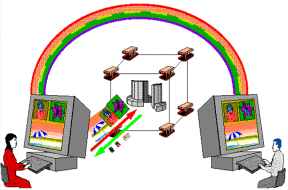Sharable Parallel Image Compression Algorithms
Objective: The objective of the parallel image compression activity is to develop and implement adaptive image compression techniques on massively parallel architectures to meet NASA's needs of sharing real-time video and image compression.
Approach: An adaptive block compression algorithm has been proposed, in that the smoother the image, the larger the compression ratio. First, Original images are divided into blocks of NxN(maximal block size); then each block is statistically analyzed and categorized as smooth or unsmooth in consideration of the human visual properties. Every smooth block is encoded using its size and mean value, while every unsmooth block has to be further divided and analyzed.
 This approach is unique in its simplicity and efficiency, allowing a straight- forward parallel implementation. Since images are compressed blockwise and there is no data dependency between blocks, each block may request one processor for its processing. After being analyzed, those smooth blocks need no more computation, thus can free the processors; while those unsmooth blocks may request more processors for their further computations. This dynamic allocation of available processors is capable of achieving load balancing.
This approach is unique in its simplicity and efficiency, allowing a straight- forward parallel implementation. Since images are compressed blockwise and there is no data dependency between blocks, each block may request one processor for its processing. After being analyzed, those smooth blocks need no more computation, thus can free the processors; while those unsmooth blocks may request more processors for their further computations. This dynamic allocation of available processors is capable of achieving load balancing.
Accomplishments: This proposed compression algorithm has been implemented in C/UNIX on SUN work station and tested on more than 50 standard images, which gave out promising results. Its parallelization is being implemented on IBM SP2. Several parallel techniques have been studied and tested on PVM and IBM SP1. However, work on parallel compression algorithm implementation was delayed due to the upgrading of SP1 to SP2 at MHPCC.
Significance: Modern space and earth exploratory technology has enabled rapid acquiring of huge amount scientific data, among which most are image and video signals. Thus image compression plays an essential role in data transmission and storage.
Status/Plans: The serial program has been implemented and tested. An effort is underway to parallelize it on IBM SP2 and realize real-time compression. Various possible improvements of the algorithm are also in consideration.
Point of Contact:
Dr. David Y. Y. Yun
Department of Electrical Engineering
University of Hawaii at Manoa
(808)956-7627, (808)956-6349
dyun@wiliki.eng.hawaii.edu
curator: Larry Picha
 This approach is unique in its simplicity and efficiency, allowing a straight- forward parallel implementation. Since images are compressed blockwise and there is no data dependency between blocks, each block may request one processor for its processing. After being analyzed, those smooth blocks need no more computation, thus can free the processors; while those unsmooth blocks may request more processors for their further computations. This dynamic allocation of available processors is capable of achieving load balancing.
This approach is unique in its simplicity and efficiency, allowing a straight- forward parallel implementation. Since images are compressed blockwise and there is no data dependency between blocks, each block may request one processor for its processing. After being analyzed, those smooth blocks need no more computation, thus can free the processors; while those unsmooth blocks may request more processors for their further computations. This dynamic allocation of available processors is capable of achieving load balancing.
 Return to the PREVIOUS PAGE
Return to the PREVIOUS PAGE